Παράδειγμα σχεδιασμού πλάκας βάσης χρησιμοποιώντας το EN 1993-1-8-2005, ΣΕ 1993-1-1-2005 και EN 1992-1-1-2004
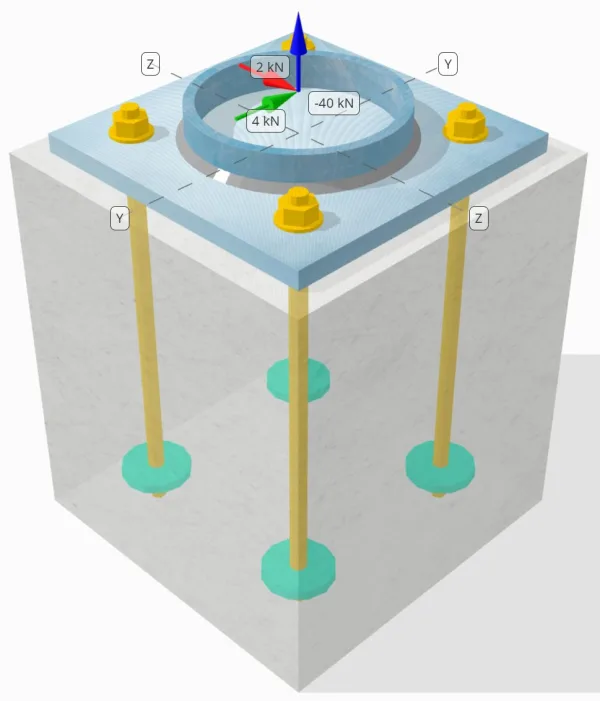
Προβληματική δήλωση
Προσδιορίστε εάν η σχεδιασμένη σύνδεση στήλης-πλάκας βάσης είναι επαρκής για α 50-kN φορτίο εφελκυσμού, 4-kN Διατμητικό φορτίο, και 2-kN Vz διατμητικό φορτίο.
Δεδομένα
Στήλη:
Ενότητα στήλης: CHS193.7×10
Επιφάνεια στήλης: 5770.0 mm²
Υλικό στήλης: S460
Πλάκα βάσης:
Διαστάσεις πλάκας βάσης: 300mm x 300 mm
Πάχος πλάκας βάσης: 18χιλ
Υλικό πλάκας βάσης: S235
Πηκτώ:
Πάχος ενέματα: 0 χιλ
Σκυρόδεμα:
Διαστάσεις σκυροδέματος: 350mm x 350 mm
Πάχος σκυροδέματος: 400 χιλ
Σκυρόδεμα: C35/45
Ραγισμένα ή αδιευκρίνιστα: Ραγισμένος
Άγκυρες:
Διάμετρος άγκυρας: 16 χιλ
Αποτελεσματικό μήκος ενσωμάτωσης: 350 χιλ
Διάμετρος ενσωματωμένης πλάκας: 70 χιλ
Ενσωματωμένο πάχος πλάκας: 10 χιλ
Υλικό άγκυρας: 4.8
Συγκολλήσεις:
Τύπος συγκόλλησης: Φιλέτο
Μέγεθος συγκόλλησης: 7χιλ
Η ταξινόμηση μετάλλων πλήρωσης: Ε42
Δεδομένα αγκυροβόλησης (από Υπολογιστής Skyciv):
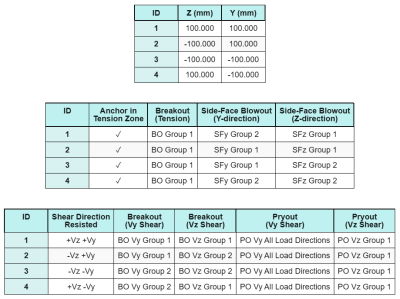
Μοντέλο στο δωρεάν εργαλείο SkyCiv
Μοντελοποιήστε το παραπάνω σχέδιο πλάκας βάσης χρησιμοποιώντας το δωρεάν διαδικτυακό μας εργαλείο σήμερα! Δεν απαιτείται εγγραφή.
Σημειώσεις
Ο σκοπός αυτού του παραδείγματος σχεδιασμού είναι να επιδείξει τους βαθμιαίους υπολογισμούς για ελέγχους χωρητικότητας που περιλαμβάνουν ταυτόχρονα διατμητικά και αξονικά φορτία. Ορισμένοι από τους απαιτούμενους ελέγχους έχουν ήδη συζητηθεί στα προηγούμενα παραδείγματα σχεδιασμού. Ανατρέξτε στους συνδέσμους που παρέχονται σε κάθε ενότητα.
Υπολογισμοί βήμα προς βήμα
Ελεγχος #1: Υπολογίστε τη χωρητικότητα συγκόλλησης
Το γεμάτο εφελκυστικό φορτίο αντιστέκεται από το ολόκληρο το τμήμα συγκόλλησης, ενώ το εξαρτήματα διατμητικού φορτίου κατανέμονται μόνο σε ένα μέρος του συνολικού μήκους συγκόλλησης. Αυτό το τμήμα προσδιορίζεται με προβολή α 90° τομέα από το κέντρο της στήλης μέχρι την περιφέρειά της. Επομένως, μόνο το ήμισυ της συνολικής περιφέρειας έχει σχεδιαστεί για να αντέχει στο διατμητικό φορτίο.
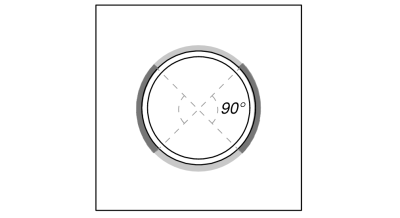
Αρχικά υπολογίζουμε το Συνολικό μήκος συγκόλλησης και το τμήμα της συγκόλλησης εντός της προβολής 90°.
\(ΜΕΓΑΛΟ_{συγκόλληση,γεμάτος} = pi d_{διάσελο} = pi φορές 193.7\ \κείμενο{χιλ} = 608.53\ \κείμενο{χιλ}\)
\(ΜΕΓΑΛΟ_{συγκόλληση} = frac{\pi d_{διάσελο}}{2} = frac{\pi φορές 193.7\ \κείμενο{χιλ}}{2} = 304.26\ \κείμενο{χιλ}\)
Επόμενο, υπολογίζουμε το προκύπτον διατμητικό φορτίο.
\(V_r = \sqrt{(V_y)^ 2 + (V_z)^ 2} = sqrt{(4\ \κείμενο{ΚΝ})^ 2 + (2\ \κείμενο{ΚΝ})^ 2} = 4.4721\ \κείμενο{ΚΝ}\)
Στη συνέχεια υπολογίζουμε το κανονικός και διατμητικές τάσεις, λαμβάνοντας υπόψη την υποτιθέμενη κατανομή φορτίου.
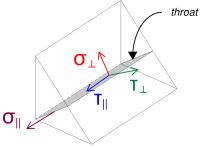
\( \σίγμα{\αδ} = frac{N_x}{ΜΕΓΑΛΟ_{συγκόλληση,γεμάτος}\,a\,\sqrt{2}} = frac{40\ \κείμενο{ΚΝ}}{608.53\ \κείμενο{χιλ} \φορές 4.95\ \κείμενο{χιλ} \φορές sqrt{2}} = 9.39\ \κείμενο{MPa} \)
\( \τα δικα σου_{\αδ} = frac{N_x}{ΜΕΓΑΛΟ_{συγκόλληση,γεμάτος}\,a\,\sqrt{2}} = frac{40\ \κείμενο{ΚΝ}}{608.53\ \κείμενο{χιλ} \φορές 4.95\ \κείμενο{χιλ} \φορές sqrt{2}} = 9.39\ \κείμενο{MPa} \)
\( \τα δικα σου_{\παράλληλο} = frac{V_r}{ΜΕΓΑΛΟ_{συγκόλληση}\,ένα} = frac{4.4721\ \κείμενο{ΚΝ}}{304.26\ \κείμενο{χιλ} \φορές 4.95\ \κείμενο{χιλ}} = 2.9693\ \κείμενο{MPa} \)
Μετά από αυτό, υπολογίζουμε το συνδυασμένα στρες χρησιμοποιώντας ΣΕ 1993-1-8:2005 Εξ. (4.1).
\(ΦΑ_{β,Ed1} = sqrt{(\σίγμα{\αδ})^ 2 + 3\μεγάλος((\τα δικα σου_{\αδ})^ 2 + (\τα δικα σου_{\παράλληλο})^2\big)}\)
\(ΦΑ_{β,Ed1} = sqrt{(9.39\ \κείμενο{MPa})^ 2 + 3\μεγάλος((9.39\ \κείμενο{MPa})^ 2 + (2.9693\ \κείμενο{MPa})^2\big)}\)
\(ΦΑ_{β,Ed1} = 19.471\ \κείμενο{MPa}\)
Την ίδια στιγμή, καθορίζουμε το πίεση στο βασικό μέταλλο χρησιμοποιώντας την ίδια εξίσωση.
\(ΦΑ_{β,Ed2} = \sigma_{\αδ} = 9.39\ \κείμενο{MPa}\)
Επόμενο, υπολογίζουμε το χωρητικότητα συγκόλλησης. Καθορίζουμε πρώτα το απόλυτη αντοχή σε εφελκυσμό (fu) Αγοράστε το μοντέλο φόρτωσης τώρα ασθενέστερο υλικό, και μετά χρησιμοποιήστε ΣΕ 1993-1-8:2005 Εξ. (4.1) για να αποκτήσετε το αντίσταση συγκόλλησης φιλέτου και αντίσταση βασικού μετάλλου.
\(f_u = \min\!\αριστερά(ΦΑ_{εσύ,\κείμενο{διάσελο}},\ φά_{εσύ,\κείμενο{bp}},\ φά_{εσύ,β}\σωστά) = \min\!\αριστερά(550\ \κείμενο{MPa},\ 360\ \κείμενο{MPa},\ 500\ \κείμενο{MPa}\σωστά) = 360\ \κείμενο{MPa}\)
\(ΦΑ_{β,Rd1} = frac{f_u}{\beta_w\,(\η δύναμη ολίσθησης είναι το άθροισμα της προκύπτουσας οριζόντιας δύναμης από την ενεργό πίεση του εδάφους στην ενεργή πλευρά του εδάφους και της προκύπτουσας οριζόντιας δύναμης από την παρουσία της πρόσθετης επιβάρυνσης{M2,\text{συγκόλληση}})} = frac{360\ \κείμενο{MPa}}{0.8 \φορές (1.25)} = 360\ \κείμενο{MPa}\)
\(ΦΑ_{β,Rd2} = frac{0.9\,f_u}{\η δύναμη ολίσθησης είναι το άθροισμα της προκύπτουσας οριζόντιας δύναμης από την ενεργό πίεση του εδάφους στην ενεργή πλευρά του εδάφους και της προκύπτουσας οριζόντιας δύναμης από την παρουσία της πρόσθετης επιβάρυνσης{M2,\text{συγκόλληση}}} = frac{0.9 \φορές 360\ \κείμενο{MPa}}{1.25} = 259.2\ \κείμενο{MPa}\)
Από 19.471 MPa < 360 MPa, Η χωρητικότητα συγκόλλησης είναι επαρκής.
Ελεγχος #2: Υπολογίστε τη χωρητικότητα κάμψης πλάκας βάσης λόγω φορτίου τάσης
Ένα παράδειγμα σχεδίασης για την ικανότητα κάμψης της πλάκας βάσης έχει ήδη συζητηθεί στο Παράδειγμα σχεδίασης πλάκας βάσης για τάση. Ανατρέξτε σε αυτόν τον σύνδεσμο για τον βήμα προς βήμα υπολογισμό.
Ελεγχος #3: Υπολογίστε τη χωρητικότητα ξεμπλοκάρισμα από σκυρόδεμα σε ένταση
Ένα παράδειγμα σχεδίασης για την ικανότητα του σκυροδέματος σε διάσπαση λόγω φορτίου εφελκυσμού έχει ήδη συζητηθεί στο Παράδειγμα σχεδίασης πλάκας βάσης για τάση. Ανατρέξτε σε αυτόν τον σύνδεσμο για τον βήμα προς βήμα υπολογισμό.
Ελεγχος #4: Υπολογίστε την χωρητικότητα αγκύρωσης
Ένα παράδειγμα σχεδίασης για την ικανότητα έλξης αγκύρωσης έχει ήδη συζητηθεί στο Παράδειγμα σχεδίασης πλάκας βάσης για τάνυση. Ανατρέξτε σε αυτόν τον σύνδεσμο για τον βήμα προς βήμα υπολογισμό.
Ελεγχος #5: Υπολογίστε την χωρητικότητα εκτόξευσης πλευρικού προσώπου σε κατεύθυνση y
Ένα παράδειγμα σχεδίασης για την ικανότητα εκτόξευσης πλευρικής όψης στην κατεύθυνση Υ έχει ήδη συζητηθεί στο Παράδειγμα σχεδίασης πλάκας βάσης για τάνυση. Ανατρέξτε σε αυτόν τον σύνδεσμο για τον βήμα προς βήμα υπολογισμό.
Ελεγχος #6: Υπολογίστε την χωρητικότητα εκτόξευσης πλευρικού προσώπου στην κατεύθυνση z
Ένα παράδειγμα σχεδίασης για την ικανότητα εκτόξευσης πλευρικής όψης στην κατεύθυνση Z έχει ήδη συζητηθεί στο Παράδειγμα σχεδίασης πλάκας βάσης για τάνυση. Ανατρέξτε σε αυτόν τον σύνδεσμο για τον βήμα προς βήμα υπολογισμό.
Ελεγχος #7: Υπολογίστε τη φέρουσα ικανότητα της πλάκας βάσης στις οπές αγκύρωσης (Με διάτμηση)
Ένα παράδειγμα σχεδίασης για τη φέρουσα ικανότητα της πλάκας βάσης στις οπές αγκύρωσης για διάτμηση Vy έχει ήδη συζητηθεί στο Παράδειγμα σχεδίασης πλάκας βάσης για συμπίεση και διάτμηση. Ανατρέξτε σε αυτόν τον σύνδεσμο για τον βήμα προς βήμα υπολογισμό.
Ελεγχος #8: Υπολογίστε τη φέρουσα ικανότητα της πλάκας βάσης στις οπές αγκύρωσης (Vz διάτμηση)
Ένα παράδειγμα σχεδίασης για τη φέρουσα ικανότητα της πλάκας βάσης στις οπές αγκύρωσης για διάτμηση Vz έχει ήδη συζητηθεί στο Παράδειγμα σχεδίασης πλάκας βάσης για συμπίεση και διάτμηση. Ανατρέξτε σε αυτόν τον σύνδεσμο για τον βήμα προς βήμα υπολογισμό.
Ελεγχος #9: Υπολογίστε την ικανότητα διάσπασης σκυροδέματος (Με διάτμηση)
Ένα παράδειγμα σχεδιασμού για την ικανότητα σκυροδέματος σε αστοχία διάσπασης λόγω διάτμησης Vy έχει ήδη συζητηθεί στο Παράδειγμα Σχεδιασμού Βάσης Πλάκας για Διάτμηση. Ανατρέξτε σε αυτόν τον σύνδεσμο για τον βήμα προς βήμα υπολογισμό.
Ελεγχος #10: Υπολογίστε την ικανότητα διάσπασης σκυροδέματος (Vz διάτμηση)
Ένα παράδειγμα σχεδίασης για την ικανότητα σκυροδέματος σε αστοχία διάσπασης λόγω διάτμησης Vz έχει ήδη συζητηθεί στο Παράδειγμα σχεδίασης πλάκας βάσης για διάτμηση. Ανατρέξτε σε αυτόν τον σύνδεσμο για τον βήμα προς βήμα υπολογισμό.
Ελεγχος #11: Υπολογίστε την ικανότητα εκτόξευσης
Ένα παράδειγμα σχεδίασης για την ικανότητα εκτόξευσης σκυροδέματος έχει ήδη συζητηθεί στο Παράδειγμα Σχεδίασης Πλάκας Βάσης για Διάτμηση. Ανατρέξτε σε αυτόν τον σύνδεσμο για τον βήμα προς βήμα υπολογισμό.
Ελεγχος #12: Υπολογίστε την ικανότητα διάτμησης της ράβδου αγκύρωσης
Η επίδραση του φορτίο τάσης στη χωρητικότητα της ράβδου αγκύρωσης θεωρείται σε αυτόν τον έλεγχο εάν η Η δύναμη διάτμησης δρα με μοχλοβραχίονα. Ωστόσο, σε αυτό το παράδειγμα, ενεργεί η διάτμηση χωρίς μοχλό βραχίονα. Επομένως, η αλληλεπίδραση μεταξύ των τάσεων διάτμησης και εφελκυσμού στη ράβδο αγκύρωσης θα αξιολογηθεί χωριστά στο έλεγχος αλληλεπίδρασης.
Για τον βαθμιαία υπολογισμό της διατμητικής ικανότητας χωρίς μοχλοβραχίονα, ανατρέξτε σε αυτόν τον σύνδεσμο.
Το λογισμικό SkyCiv Base Plate Design μπορεί να εκτελέσει όλους τους απαραίτητους ελέγχους για να προσδιορίσει εάν το διατμητικό φορτίο ενεργεί με ή χωρίς μοχλοβραχίονα. Μπορείς δοκιμάστε το δωρεάν εργαλείο σήμερα.
Ελεγχος #13: Υπολογίστε τον έλεγχο αλληλεπίδρασης χάλυβα άγκυρας
Χρησιμοποιούμε ΣΕ 1992-4:2018 Τραπέζι 7.3 Εξ. (7.54) Για να αξιολογήσετε το αλληλεπίδραση μεταξύ των τάσεων διάτμησης και εφελκυσμού στη ράβδο της άγκυρας. Αντικαθιστώντας την εφελκυστική τάση και ικανότητα καθώς και τη διατμητική τάση και ικανότητα στην εξίσωση, το προκύπτον αξία αλληλεπίδρασης είναι:
\(ΕΓΩ_{int} = αριστερά(\frac{Ν_{Εκδ}}{Ν_{Rd,μικρό}}\σωστά)^ 2 + \αριστερά(\frac{V_{Εκδ}}{V_{Rd,μικρό}}\σωστά)^2)
\(ΕΓΩ_{int} = αριστερά(\frac{10\ \κείμενο{ΚΝ}}{49.22\ \κείμενο{ΚΝ}}\σωστά)^ 2 + \αριστερά(\frac{1.118\ \κείμενο{ΚΝ}}{38.604\ \κείμενο{ΚΝ}}\σωστά)💕⬛ Αγορά Indocin από 0.042117\)
Από 0.042 < 1.0, ο έλεγχος αλληλεπίδρασης αστοχίας χάλυβα ράβδου αγκύρωσης είναι επαρκής.
Ελεγχος #14: Υπολογίστε τον έλεγχο αλληλεπίδρασης αστοχίας σκυροδέματος
Ενα επιπλέον έλεγχος αλληλεπίδρασης απαιτείται για συγκεκριμένες αστοχίες υπό ταυτόχρονη φόρτιση διάτμησης και εφελκυσμού. Για αυτό, χρησιμοποιούμε ΣΕ 1992-4:2018 Τραπέζι 7.3 Εξ. (7.55) και Εξ. (7.56).
Εδώ είναι οι αναλογίες που προκύπτουν για όλους έλεγχοι εφελκυσμού.

Εδώ είναι οι αναλογίες που προκύπτουν για όλους διατμητικούς ελέγχους.

Πρώτα, ελέγχουμε χρησιμοποιώντας Εξ. (7.55) και συγκρίνετε το αποτέλεσμα με το μέγιστο όριο αλληλεπίδρασης του 1.0.
\(ΕΓΩ_{\κείμενο{περίπτωση 1}} = αριστερά(\αριστερά(\frac{Ν_{Εκδ}}{Ν_{Rd}}\σωστά)^{1.5}\σωστά) + \αριστερά(\αριστερά(\frac{V_{Εκδ}}{V_{Rd}}\σωστά)^{1.5}\σωστά)\)
\(ΕΓΩ_{\κείμενο{περίπτωση 1}} = αριστερά(\αριστερά(\frac{40}{45.106}\σωστά)^{1.5}\σωστά) + \αριστερά(\αριστερά(\frac{4.1231}{14.296}\σωστά)^{1.5}\σωστά) = 0.99\)
Επόμενο, ελέγχουμε χρησιμοποιώντας Εξ. (7.56) και συγκρίνετε το αποτέλεσμα με το μέγιστο όριο αλληλεπίδρασης του 1.2.
\(ΕΓΩ_{\κείμενο{περίπτωση 2}} = frac{Ν_{Εκδ}}{Ν_{Rd}} + \frac{V_{Εκδ}}{V_{Rd}} = frac{40}{45.106} + \frac{4.1231}{14.296} = 1.1752\)
Από 0.99 < 1.0 και 1.175 < 1.2, ο έλεγχος αλληλεπίδρασης αστοχίας σκυροδέματος είναι επαρκής.
Περίληψη σχεδίου
ο Λογισμικό σχεδιασμού πλάκας βάσης SkyCIV Μπορεί να δημιουργήσει αυτόματα μια αναφορά υπολογισμού βήμα προς βήμα για αυτό το παράδειγμα σχεδιασμού. Παρέχει επίσης μια περίληψη των επιταγών που εκτελούνται και των προκύπτουσων αναλογιών τους, καθιστώντας τις πληροφορίες κατανοητές με μια ματιά. Παρακάτω είναι ένας πίνακας συνοπτικών δείγματος, που περιλαμβάνεται στην αναφορά.
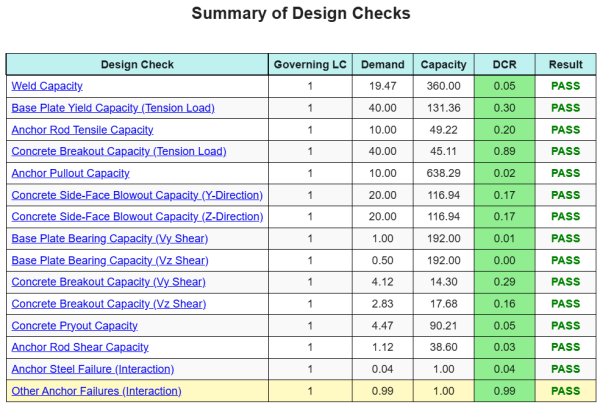
Αναφορά δείγματος SkyCIV
Δείτε το επίπεδο λεπτομέρειας και σαφήνειας που μπορείτε να περιμένετε από μια αναφορά σχεδίασης πλάκας βάσης SkyCiv. Η αναφορά περιλαμβάνει όλους τους βασικούς ελέγχους σχεδιασμού, εξισώσεις, και τα αποτελέσματα παρουσιάζονται σε σαφή και ευανάγνωστη μορφή. Είναι πλήρως συμβατό με τα πρότυπα σχεδιασμού. Κάντε κλικ παρακάτω για να προβάλετε ένα δείγμα αναφοράς που δημιουργήθηκε με χρήση του SkyCiv Base Plate Calculator.
(Δείγμα αναφοράς που θα προστεθεί σύντομα)
Αγορά λογισμικού πλάκας βάσης
Αγοράστε την πλήρη έκδοση της μονάδας σχεδιασμού πλάκας βάσης από μόνη της χωρίς άλλες ενότητες SkyCIV. Αυτό σας δίνει ένα πλήρες σύνολο αποτελεσμάτων για σχεδιασμό πλάκας βάσης, συμπεριλαμβανομένων λεπτομερών αναφορών και περισσότερων λειτουργιών.


